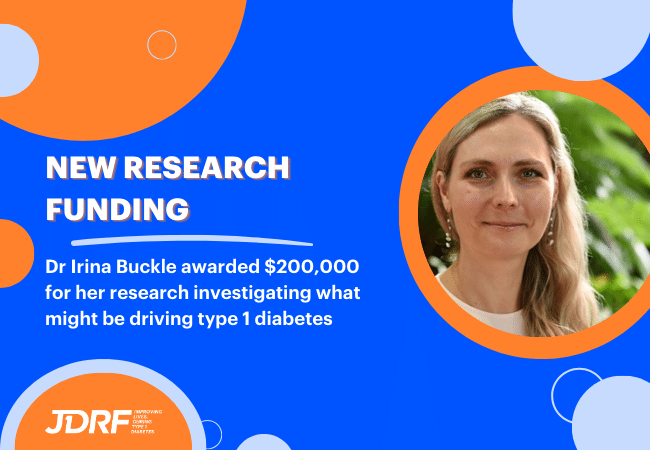Top 10 T1D Research Breakthroughs of 2020
While COVID-19 has dominated the news in 2020, it’s also been a huge year for type 1 diabetes research. This year, we’ve made more progress than ever on our mission to cure, treat and prevent T1D – including new insights into what causes the disease, some incredible results from prevention therapies, and the launch of two world-first clinical trials in Australia. Let’s look back on 2020 by celebrating the 10 biggest T1D research breakthroughs:
1. World-first clinical trial launched in Melbourne
St Vincent’s Institute of Medical Research, with funding from JDRF, launched a clinical trial of baricitinib – a drug that aims to stop the immune system from attacking beta cells. If successful, the researchers hope that baricitinib could help people with newly diagnosed T1D keep producing their own insulin for longer.
2. Australia’s first population screening program for T1D
In February, JDRF announced that Dr Kirstine Bell will lead a pilot study to screen children for early signs of T1D. This study will be the first in Australia – and one of only three in the world – to screen people from the general population, without a family history of T1D. The screening program could identify those most at risk of T1D before they develop symptoms.
3. Teplizumab delays T1D diagnosis by 3 years
The American Diabetes Association (ADA) Scientific Sessions were held virtually for the first time this year. The biggest news to come out of the sessions was updated results on teplizumab as a treatment to delay T1D diagnosis. The effects of teplizumab have been sustained even longer, with half of people taking the drug remaining diabetes-free after 3 years, compared with 22% of those taking placebo.
4. New insights into what causes T1D
Also at ADA, Dr Marian Rewers presented updated results from The Environmental Determinants of Diabetes in Youth (TEDDY) study. TEDDY has screened almost half a million children across the US, Finland, Sweden and Germany for islet autoantibodies, one of the earliest signs of T1D. The researchers found that islet autoantibodies generally develop very early, and that children who develop them have a different combination of bacteria in their gut to children who don’t.
5. Breakthrough results for closed-loop technology
In October, the first results from a large JDRF-funded clinical trial of closed-loop technology were published. The trial, led by Prof David O’Neal from the University of Melbourne, showed that time-in-range increased by 15 percentage points in the group using the hybrid closed-loop system. This group also experienced lower average glucose levels and HbA1c, as well as scoring better on quality of life measures.
6. ENDIA study extended
This year, the ENDIA study – Australia’s largest study into the causes of T1D – received $8.25 million in further funding from JDRF Australia and The Leona M. and Harry B. Helmsley Charitable Trust. The funding is being used to continue follow-up of ENDIA’s 1500 participants for a further three years.
7. Gut bacteria and T1D
The European Association for the Study of Diabetes (EASD) meeting also went virtual this year, with Australian researchers strongly represented. A/Prof Emma Hamilton-Williams from the University of Queensland shared preliminary results from a clinical trial of a diet-based therapy for people with T1D. The fibre-based diet is showing early promise as a way of modifying gut bacteria in people with T1D, and may even affect blood glucose management.
8. Two subtypes of T1D?
Earlier this year, researchers in the UK discovered that there might be two subtypes of T1D in children – with those diagnosed under 7 years old seeming to have a different form of the condition to those aged 13 and over. The results could have big implications for the development of new treatments – depending on how they work, some immunotherapies might be more effective for children in one age group, and less effective for others.
9. Targeting T1D complications
Prof Merlin Thomas from Monash University has found that a protein in the body called RAGE plays an important role in T1D complications. When RAGE is absent from cells, this can protect against the development of complications like kidney, eye and heart disease. Prof Thomas and his team have also found new ways to target RAGE with potential therapies, meaning the protein will be an important area of focus for future studies on the prevention of T1D complications.
10. Screening success in Germany
A study of nearly 100,000 children in Germany, supported by JDRF, has shown that screening the population for T1D risk before symptoms start can greatly reduce rates of diabetic ketoacidosis (DKA). The rate of DKA in the islet autoantibody screening study was less than 5%, compared to the usual rate of 20% in Germany. The success of the Fr1da study shows that a similar program would not only be feasible in other countries, but that it could have significant benefits for children with T1D and their families.




